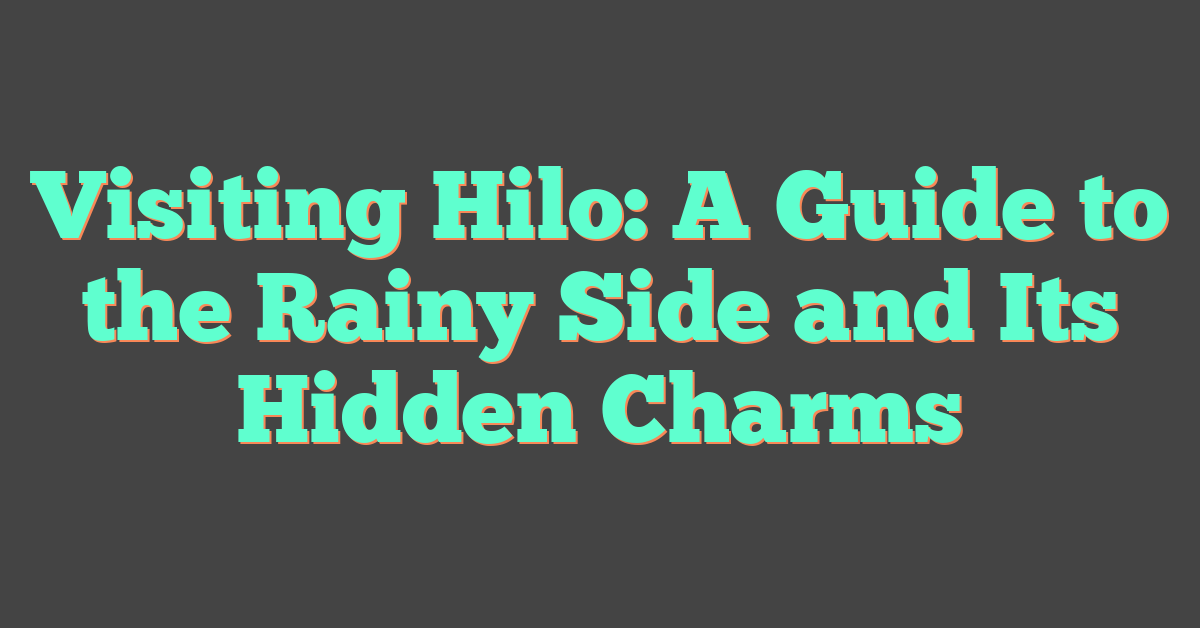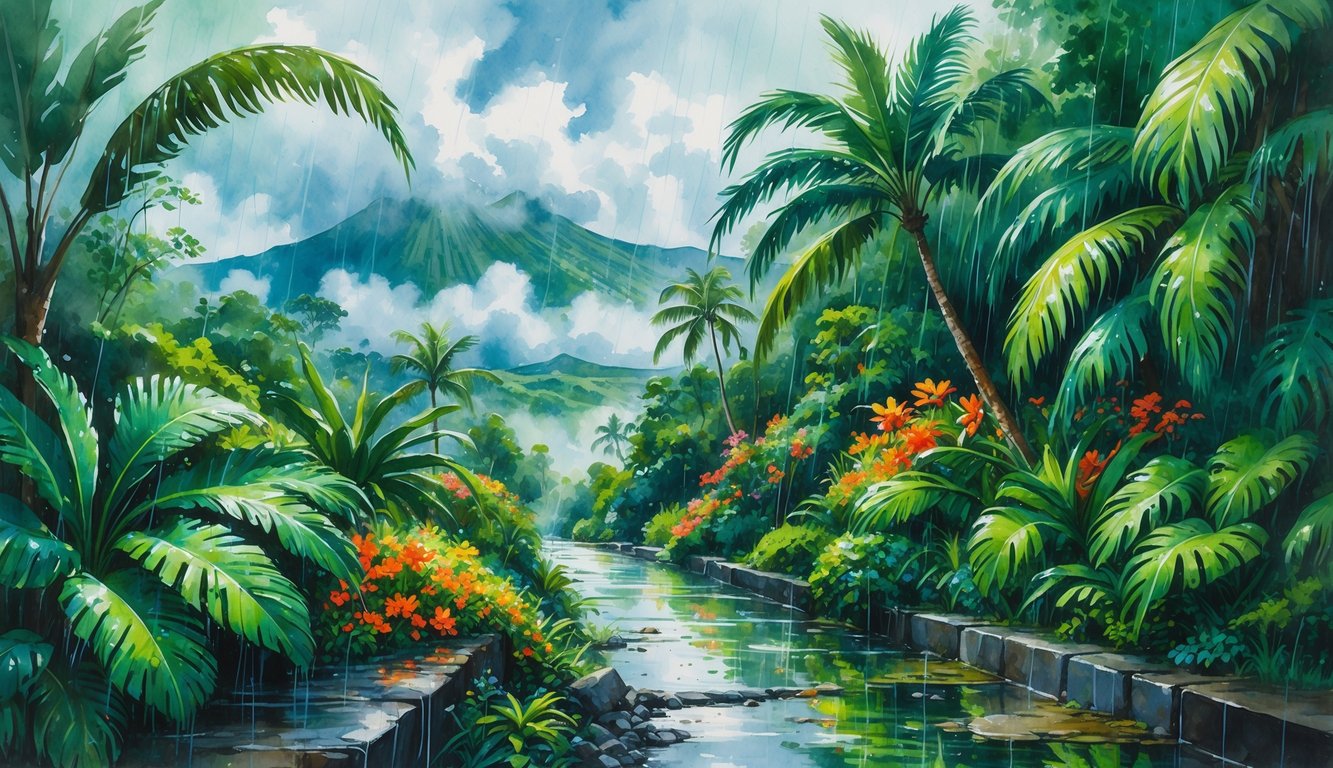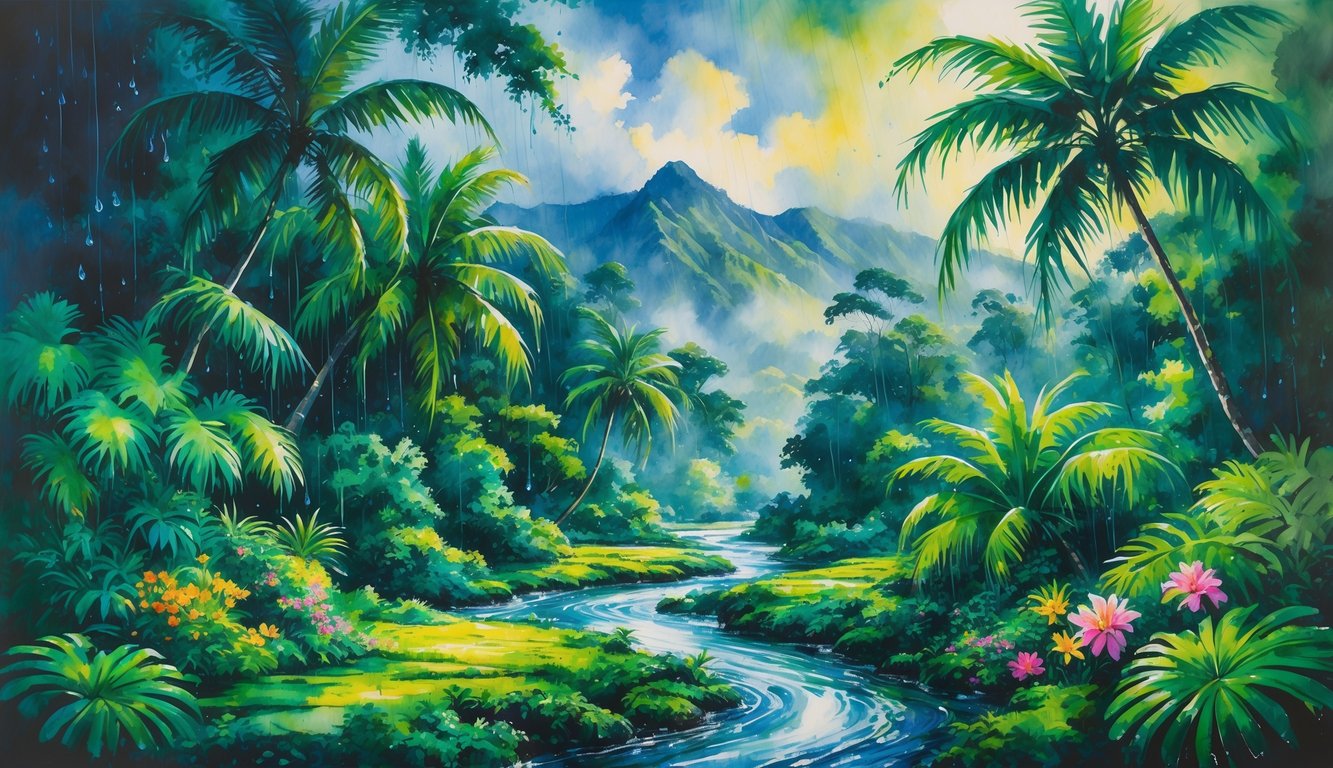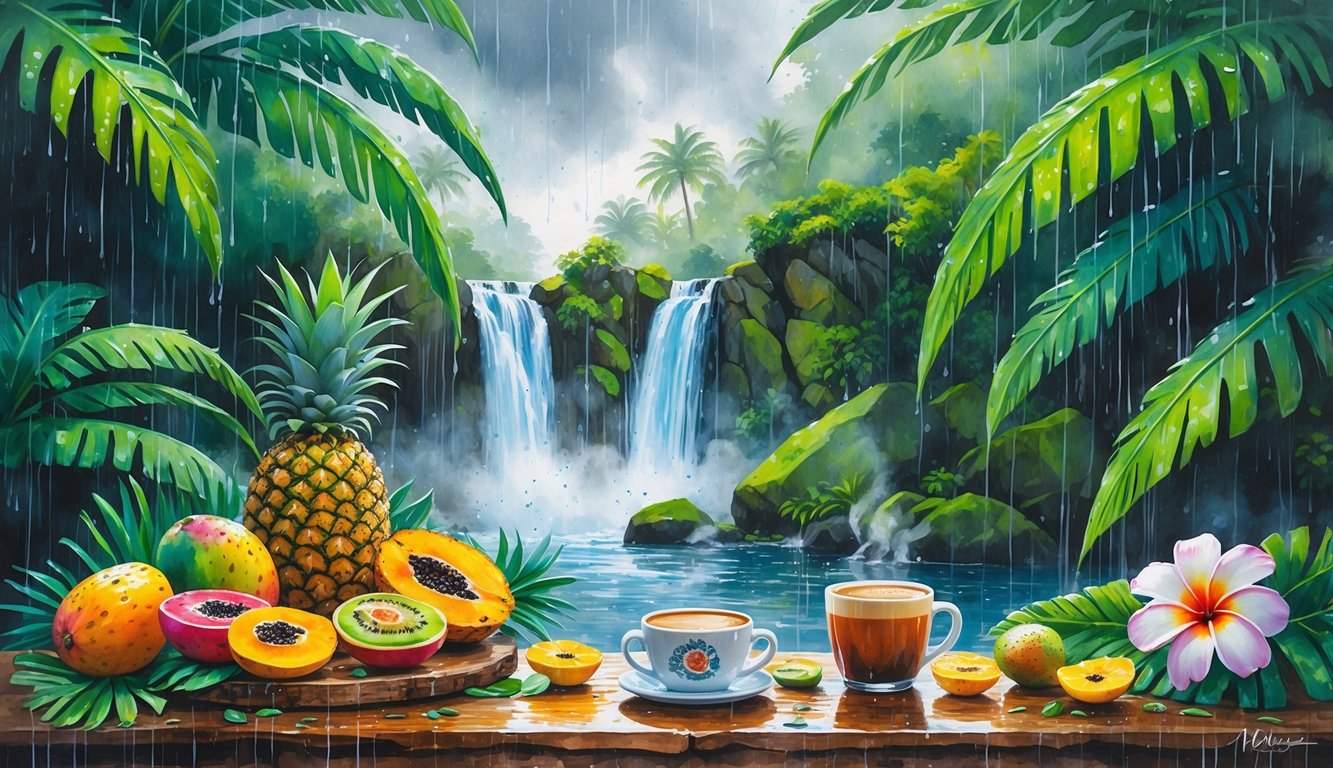Hilo sits on the lush eastern coast of the Big Island. Warm trade winds bring frequent showers from the Pacific.

This side of the Hawaiian Islands receives far more rainfall than the sunny Kona coast. Waterfalls, gardens, and vibrant greenery fill the landscape.
Visiting Hilo means embracing its rainy charm and enjoying natural beauty, culture, and local life.

Explorers in Hilo find that the rain rarely stops the fun. You can stroll through the colorful Hilo Farmers Market or visit the stunning Rainbow Falls.
On wet days, museums, galleries, and cultural centers offer plenty of ways to experience the area’s history and art. The town also makes a great base for adventures beyond its borders.
You can easily reach Volcanoes National Park, scenic drives along the Hamakua Coast, and nearby botanical gardens. Hilo’s slower pace and authentic Hawaiian feel offer a different side of the Big Island.
Why Hilo Is the Rainy Side of the Big Island
Hilo sits on the windward side of the Big Island. Warm, moist air from the Pacific meets the slopes of Mauna Kea and Mauna Loa here.
This location brings frequent rainfall, supporting lush rainforests, waterfalls, and vibrant plant life year-round. Visitors often notice a big contrast with the island’s drier west side.
Understanding Hilo’s Unique Climate
Hilo’s climate forms because trade winds carry moisture from the ocean. When these winds reach the island’s tall volcanic mountains, the air rises and cools, releasing rain.
This process, called orographic rainfall, happens often. Hilo averages over 120 inches of rain each year, and some areas receive over 200 inches.
Unlike the Kona side, which is dry and sunny, Hilo experiences light showers, steady rain, and occasional heavy downpours. Many showers pass quickly, and sunny breaks often follow.
The consistent moisture keeps temperatures mild, usually between 70°F and 85°F. This makes the climate comfortable despite the frequent rain.
How Rainfall Shapes the Local Landscape
Rainfall creates Hilo’s tropical paradise. The constant moisture feeds dense rainforests filled with ferns, orchids, and towering trees.
It also keeps the island’s most famous waterfalls, like Rainbow Falls and Akaka Falls, flowing. These waterfalls look most impressive after heavy rain.
Streams and rivers flow year-round, and the soil stays rich. Local farms grow papayas, orchids, and other tropical crops.
Moss and greenery cover rocks, walls, and even rooftops. This gives Hilo a lush, natural look that stands out from the dry lava fields on the leeward side of the island.
The Best Times to Visit for Weather
It rains in Hilo throughout the year, but some months are drier. Late spring and early fall often see less rainfall.
Winter months bring heavier showers, but temperatures remain warm. If you want fewer crowds and lower prices, you may still choose these months and accept the wetter conditions.
Those who prefer more sun often plan trips for May through September. Even then, short showers are likely, but bright skies usually follow.
Check the forecast before outdoor activities like hiking or visiting waterfalls. This helps you make the most of each day.
What to Pack for Hilo’s Weather
Pack for both sun and rain when visiting Hilo. Bring a light rain jacket or poncho, and wear quick-drying clothing.
Waterproof footwear helps on muddy trails near waterfalls or during rainforest hikes. An umbrella is useful for city walks, but jackets work better when it’s windy.
Bring sunscreen and sunglasses, as sunny breaks can be intense. Use a small waterproof bag or cover to protect electronics and cameras during sudden showers.
By packing smart, you can enjoy Hilo’s beauty without getting caught off guard by rain.
Top Things to Do in Hilo, Rain or Shine
Hilo offers natural beauty, cultural history, and local flavor. You can enjoy these in any weather.
From scenic outdoor spots to indoor attractions, travelers find activities for both sunny days and rainy afternoons.
Explore Downtown Hilo and the Hilo Farmers Market
Downtown Hilo features small shops, local cafes, and historic buildings. The area feels relaxed and walkable.
You can browse art galleries, bookstores, and boutiques with locally made goods. The Hilo Farmers Market is a town highlight.
The market is open daily, but Wednesdays and Saturdays are busiest, with more vendors. Shoppers find tropical fruits, fresh vegetables, flowers, and handmade crafts.
Food stalls serve local favorites like poke bowls and mochi. The market sits near the bayfront, making it easy to combine shopping with a stroll along the waterfront.
If you visit in the morning, you’ll find cooler temperatures and fresher selections.
Discover Hilo’s Waterfalls and Rainforest Trails
Hilo’s location on the wet side of the island creates lush rainforest and many waterfalls. Rainbow Falls is just a short drive from downtown and often displays a rainbow in the morning sunlight.
Along the Hamakua Coast, you can explore scenic lookouts and trails. The Hawaii Tropical Botanical Garden offers a paved path through tropical plants and ocean views.
It’s a good option for light rain since much of the trail is shaded. If you enjoy hiking, trails near Wailuku River State Park and other reserves provide views of smaller cascades and dense foliage.
Even in wet weather, the greenery and flowing water make these spots beautiful.
Experience Hilo’s Museums and Cultural Sites
Hilo has several indoor attractions that are ideal during heavy rain. The Pacific Tsunami Museum shares stories and exhibits about the 1946 and 1960 tsunamis.
The Imiloa Astronomy Center combines Hawaiian culture with space science. You can watch planetarium shows and learn about navigation by the stars.
Mokuola (Coconut Island) is a small park connected by a footbridge just offshore. It’s a peaceful place to walk, picnic, or take photos of Hilo Bay.
While better in dry weather, it’s close enough to downtown to visit between showers.
Relax in Hilo’s Parks and Gardens
Hilo’s parks and gardens offer quiet spaces to enjoy nature. Liliuokalani Park and Gardens is a Japanese-style garden with ponds, bridges, and walking paths.
It’s free to enter and open year-round. Nani Mau Gardens features tropical flowers, orchids, and landscaped grounds.
Guided tours are available for those who want to learn about the plants. The Wailoa River State Recreation Area is another open space for walking, fishing, or picnics.
Even in light rain, the scenery remains green and inviting.
Day Trips and Adventures Beyond Hilo

Travelers in Hilo can explore active volcano landscapes, drive along coastlines with waterfalls, and wander through gardens filled with rare tropical plants. These experiences highlight the Big Island’s natural diversity and are a short drive from town.
Hawaii Volcanoes National Park and Kilauea Volcano
Hawaii Volcanoes National Park sits just 45 minutes from Hilo. You can see Kilauea, one of the world’s most active volcanoes.
Walk across old lava fields, view steam vents, and learn about volcanic activity at the Kilauea Visitor Center. The park has both short walks and longer hikes.
Popular spots include the Thurston Lava Tube, where you walk through a cooled lava tunnel, and the Devastation Trail, which shows how past eruptions changed the land.
At night, when conditions allow, you might see the glow from Halemaʻumaʻu Crater. Check official park updates before visiting to plan around closures or weather changes.
Scenic Drives Along the Hamakua Coast
The Hamakua Coast north of Hilo features dramatic sea cliffs, lush valleys, and roadside waterfalls. You can drive along Highway 19 and stop at viewpoints and small towns.
Highlights include Akaka Falls State Park, where a short loop trail leads to a 442-foot waterfall, and Laupahoehoe Point, which offers ocean views and a peaceful park.
Many travelers stop at fruit stands and small cafes along the way. The route is easy to follow, making it a flexible half-day trip from Hilo.
For more ideas, check out Hamakua Coast travel tips.
Botanical Gardens and Orchid Farms
Just outside Hilo, the Hawaii Tropical Botanical Garden sits in a valley along Onomea Bay. The garden features over 2,000 plant species, with paths past orchids, palms, and ocean viewpoints.
You can explore the garden in about two hours. Benches and shaded areas make it comfortable for all ages.
Hilo also has several orchid farms, where you can see unique hybrids and learn about cultivation. Some farms sell plants and cut flowers, making them a good stop for souvenirs.
For more details, see the Hilo garden and flower guide.
Local Flavors and Unique Hilo Experiences

Hilo offers fresh island dishes, locally grown coffee, and specialty sweets. You can enjoy food made from local ingredients, meet the people who make it, and bring home treats found only on the Big Island.
Sampling Poke and Hawaiian Coffee
Poke is a staple in Hilo’s food scene. Shops and markets sell fresh ahi tuna poke seasoned with soy sauce, sesame oil, and green onions.
Some places offer spicy or wasabi flavors, while others serve marinated octopus or tofu. Hilo is also known for its Hawaiian coffee, grown in the volcanic soil of the Big Island.
Local cafés serve smooth, rich brews made from beans roasted in small batches. At the Hilo Farmers Market, you can sample poke from local vendors and sip freshly brewed coffee while browsing produce and handmade goods.
Many stalls offer tasting portions, so you can try different flavors without committing to a full meal.
Sweets and Treats at Big Island Candies
Big Island Candies has made cookies and chocolates in Hilo since 1977. They dip their signature shortbread cookies in chocolate and offer flavors like macadamia nut and Kona coffee.
You can watch the production process through large viewing windows inside the store. Staff often hand out free samples of cookies or chocolate-dipped treats.
The shop sells packaged gift boxes, making it easy to find souvenirs. They use local ingredients such as island-grown macadamia nuts and Hawaiian sea salt, giving each treat a distinct Big Island taste.
Find more details on visiting at Big Island Candies.
Tips for Enjoying Hilo Like a Local
Locals shop early at farmers markets to get the freshest produce and best poke.
If you arrive before 10 a.m., you can avoid crowds and find more options.
Locals may suggest trying coffee black to taste the natural flavor of the beans.
Many Hilo cafés serve cold brew for hot, humid mornings.
Residents buy Big Island Candies in bulk to share at gatherings or send to friends off-island.
If you talk with vendors and café owners, you may get recommendations for hidden spots not found in guidebooks.




